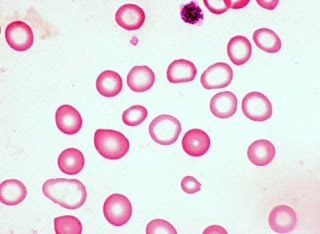Hypochromasia Definition, Symptoms, Causes, Treatment
Hypochromia is another name of hypochromasia. As the name indicates hypo means deficiency and chromia means color. When more than half diameter of cell have central pallor region or the central pallor region increases this is known as hypochromasia. In this condition, there is decreased production of hemoglobin due to deficiency of iron. Due to deficiency of iron, anemia occurs and poikilocytes are frequently present in iron lack anemia which are formed as a result of oxidation of red blood cells membrane.
It will leads to fragmentation. The concentration of hemoglobin is less as compare to the required concentration according to volume of cell. Mean corpuscular volume (MCV) is the evaluation parameter of color of anemic red blood cells and mean corpuscular hemoglobin concentration is the parameter to check effect of size of cell to its color. Hypochromia is defined when its value is less than normal mean corpuscular hemoglobin MCH. The normal range of MCH in adults is 27 to 33 picograms per cell and normal range of MCHC is 33 to 36 gram per deciliter in adults. The size of red blood cell also decreases and can overlap leading to microcytic anemia.

Hypochromasia is a cell disease which have wide range of symptoms all over the body. Tachycardia occurs and may increase up to 100 beats per minute. Due to anemia, blood concentration in body decreases and leads to fatigue and tiredness. Main symptoms of hypochromasia is weakness in body. Hypochromasia disturbs the sleep cycle. When there is decreased concentration of blood it will lead to decreased circulation in veins. Skin becomes pale. When this condition is at peak, sore mouth occurs. Menstrual cycle gets disturb due to deficiency of blood. Pica can also develop due to hypochromic anemia.
Deficiency of vit B6 in body and less intake of iron in the form of diet along with less absorption of minerals all these factors lead to hypochromasia. Parasitic infections like in case of hookworm also lead to hypochromic anemia. It may occur secondary to prescribed medications. Lead poisoning is another major reported cause now a days. It may be secondary to diseases like thalassemia and iron deficiency. Heavy periods can cause excessive blood loss and lead to hypochromasia. Ulcers and gastric bleeding can cause Hypochromia. Piles, hemorrhoids and inherited gene mutation are last but not least reported causes.
Hypochromasia can be treated via collection of treatment options. Like carbonyl iron should be administered to fulfil iron deficiency. Eculizumab is also prescribed for it. It is a monoclonal antibody. Cyanocobalamin whose other name is vitamin B6 is also recommended for vit B6 deficiency. Darbepoetin alfa and Epoetin beta-methoxy polyethylene glycol are prescribed. When it occurs due to a parasitic infection, then homeopathic remedy cina is effective. Ferrum met and ferrum phos helps in production of healthy red blood cells via stimulating bone marrow. There are some life style modifications which should be adapted like quit smoking and exercise etc.
It will leads to fragmentation. The concentration of hemoglobin is less as compare to the required concentration according to volume of cell. Mean corpuscular volume (MCV) is the evaluation parameter of color of anemic red blood cells and mean corpuscular hemoglobin concentration is the parameter to check effect of size of cell to its color. Hypochromia is defined when its value is less than normal mean corpuscular hemoglobin MCH. The normal range of MCH in adults is 27 to 33 picograms per cell and normal range of MCHC is 33 to 36 gram per deciliter in adults. The size of red blood cell also decreases and can overlap leading to microcytic anemia.

Hypochromasia Symptoms
Hypochromasia is a cell disease which have wide range of symptoms all over the body. Tachycardia occurs and may increase up to 100 beats per minute. Due to anemia, blood concentration in body decreases and leads to fatigue and tiredness. Main symptoms of hypochromasia is weakness in body. Hypochromasia disturbs the sleep cycle. When there is decreased concentration of blood it will lead to decreased circulation in veins. Skin becomes pale. When this condition is at peak, sore mouth occurs. Menstrual cycle gets disturb due to deficiency of blood. Pica can also develop due to hypochromic anemia.
Hypochromasia Causes
Deficiency of vit B6 in body and less intake of iron in the form of diet along with less absorption of minerals all these factors lead to hypochromasia. Parasitic infections like in case of hookworm also lead to hypochromic anemia. It may occur secondary to prescribed medications. Lead poisoning is another major reported cause now a days. It may be secondary to diseases like thalassemia and iron deficiency. Heavy periods can cause excessive blood loss and lead to hypochromasia. Ulcers and gastric bleeding can cause Hypochromia. Piles, hemorrhoids and inherited gene mutation are last but not least reported causes.
Hypochromasia Treatment
Hypochromasia can be treated via collection of treatment options. Like carbonyl iron should be administered to fulfil iron deficiency. Eculizumab is also prescribed for it. It is a monoclonal antibody. Cyanocobalamin whose other name is vitamin B6 is also recommended for vit B6 deficiency. Darbepoetin alfa and Epoetin beta-methoxy polyethylene glycol are prescribed. When it occurs due to a parasitic infection, then homeopathic remedy cina is effective. Ferrum met and ferrum phos helps in production of healthy red blood cells via stimulating bone marrow. There are some life style modifications which should be adapted like quit smoking and exercise etc.
Hypochromasia Definition, Symptoms, Causes, Treatment
 Reviewed by Simon Albert
on
October 13, 2019
Rating:
Reviewed by Simon Albert
on
October 13, 2019
Rating:
 Reviewed by Simon Albert
on
October 13, 2019
Rating:
Reviewed by Simon Albert
on
October 13, 2019
Rating:











